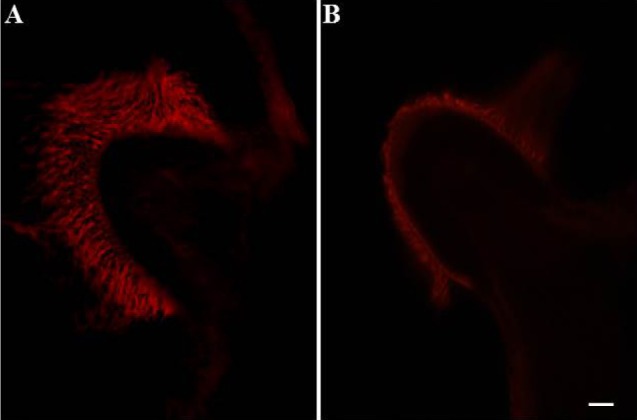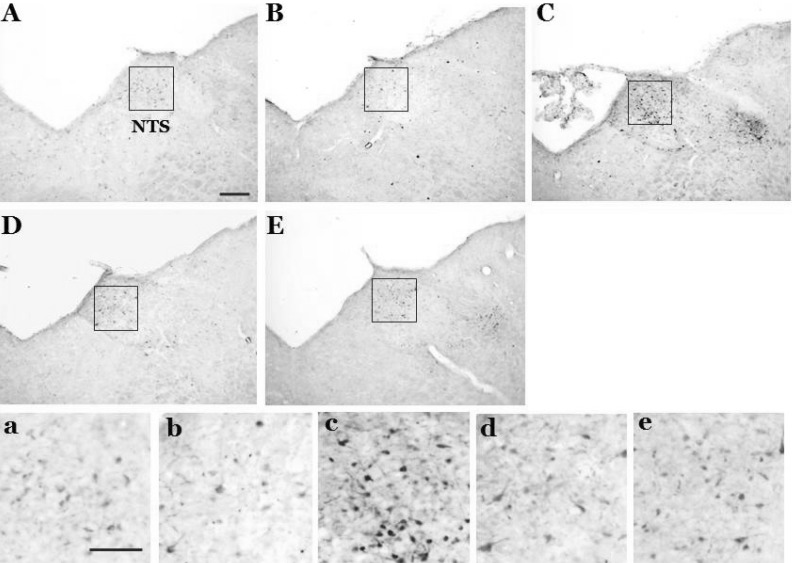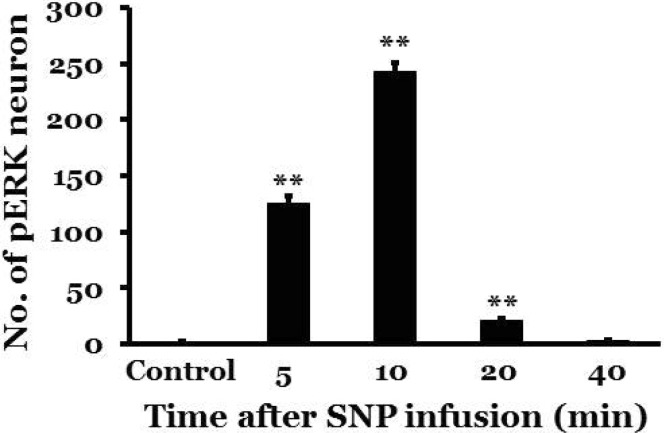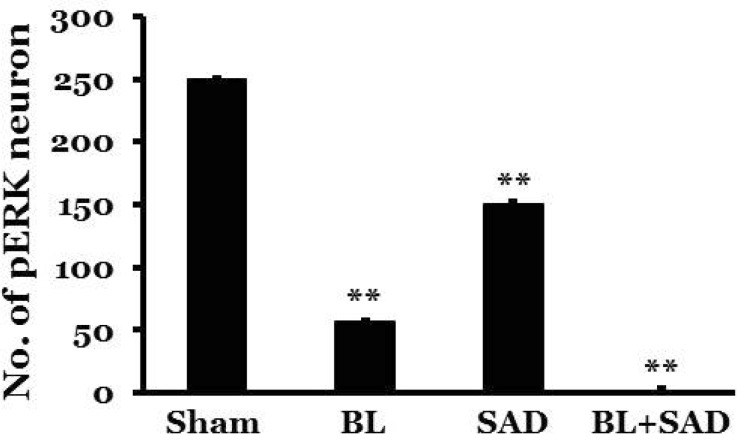Korean J Physiol Pharmacol.
2014 Aug;18(4):353-358. 10.4196/kjpp.2014.18.4.353.
Effect of Vestibulosympathetic Reflex and Baroreflex on Expression of pERK in the Nucleus Tractus Solitarius following Acute Hypotension in Conscious Rats
- Affiliations
-
- 1Department of Physiology and Pathophysiology, Yanbian University College of Medicine, Yanji 133002, China. y-z-jin@ybu.edu.cn
- 2Department of Oral Physiology, Wonkwang University College of Dentistry, Iksan 570-749, Korea.
- 3Department of Food and Nutrition, Kwangju Women's University, Gwangju 506-713, Korea.
- 4Department of Physiology, Wonkwang University School of Medicine and Brain Science Institute at Wonkwang University, Iksan 570-749, Korea. byungp@wku.ac.kr
- KMID: 2285531
- DOI: http://doi.org/10.4196/kjpp.2014.18.4.353
Abstract
- Control of blood pressure is maintained by the interaction between the arterial baroreflex and vestibulosympathetic reflex during postural changes. In this study, the contributions of vestibular receptors and baroreceptors to the maintenance of blood pressure following acute hypotension were compared in terms of phosphorylated extracellular regulated protein kinase (pERK) expression in the nucleus tractus solitaries (NTS). Expression of pERK in the NTS was measured in conscious rats that had undergone bilateral labyrinthectomy (BL) and/or sinoaortic denervation (SAD) 5, 10, 20, and 40 min following acute hypotension induced by sodium nitroprusside (SNP) infusion. Expression of pERK increased significantly in the NTS in the control group following SNP infusion, and the expression peaked at 10 min after SNP infusion. The number of pERK positive neurons increased following SNP infusion in BL, SAD, and BL+SAD groups, although the increase was smaller than in control group. The BL group showed a relatively higher reduction in pERK expression than the SAD group, and the pERK expression in the NTS was localized to the caudal portion of the nuclei in the BL and SAD groups. These results suggest that the vestibular receptors may play a key role in maintaining blood pressure following acute hypotension; thus, the vestibular system may contribute to compensate for orthostatic hypotension.
MeSH Terms
Figure
Cited by 1 articles
-
Effect of Glutamate on the Vestibulo-Solitary Projection after Sodium Nitroprusside-Induced Hypotension in Conscious Rats
Li-Wei Li, Guang-Shi Jin, Yan-Zhao Yang, Abdul Nasir Ameer, Min Sun Kim, Byung Rim Park, Yuan-Zhe Jin
Korean J Physiol Pharmacol. 2015;19(3):275-281. doi: 10.4196/kjpp.2015.19.3.275.
Reference
-
1. Normand H, Etard O, Denise P. Otolithic and tonic neck receptors control of limb blood flow in humans. J Appl Physiol (1985). 1997; 82:1734–1738. PMID: 9173934.2. Biaggioni I, Costa F, Kaufmann H. Vestibular influences on autonomic cardiovascular control in humans. J Vestib Res. 1998; 8:35–41. PMID: 9416587.
Article3. Yates BJ, Holmes MJ, Jian BJ. Adaptive plasticity in vestibular influences on cardiovascular control. Brain Res Bull. 2000; 53:3–9. PMID: 11033202.
Article4. Kerman IA, Yates BJ, McAllen RM. Anatomic patterning in the expression of vestibulosympathetic reflexes. Am J Physiol Regul Integr Comp Physiol. 2000; 279:R109–R117. PMID: 10896871.
Article5. Yates BJ, Holmes MJ, Jian BJ. Plastic changes in processing of graviceptive signals during spaceflight potentially contribute to postflight orthostatic intolerance. J Vestib Res. 2003; 13:395–404. PMID: 15096680.
Article6. Yates BJ. Vestibular influences on the sympathetic nervous system. Brain Res Brain Res Rev. 1992; 17:51–59. PMID: 1638275.
Article7. Edis AJ. Aortic baroreflex function in the dog. Am J Physiol. 1971; 221:1352–1357. PMID: 5124279.
Article8. Gotoh TM, Fujiki N, Matsuda T, Gao S, Morita H. Roles of baroreflex and vestibulosympathetic reflex in controlling arterial blood pressure during gravitational stress in conscious rats. Am J Physiol Regul Integr Comp Physiol. 2004; 286:R25–R30. PMID: 14500268.
Article9. Doba N, Reis DJ. Role of the cerebellum and the vestibular apparatus in regulation of orthostatic reflexes in the cat. Circ Res. 1974; 40:9–18. PMID: 4543723.
Article10. Balaban CD, Beryozkin G. Vestibular nucleus projections to nucleus tractus solitarius and the dorsal motor nucleus of the vagus nerve: potential substrates for vestibulo-autonomic interactions. Exp Brain Res. 1994; 98:200–212. PMID: 8050507.
Article11. Yates BJ, Grélot L, Kerman IA, Balaban CD, Jakus J, Miller AD. Organization of vestibular inputs to nucleus tractus solitarius and adjacent structures in cat brain stem. Am J Physiol. 1994; 267:R974–R983. PMID: 7524372.
Article12. Balaban CD. Vestibular nucleus projections to the parabrachial nucleus in rabbits: implications for vestibular influences on the autonomic nervous system. Exp Brain Res. 1996; 108:367–381. PMID: 8801117.
Article13. Rogers RF, Paton JF, Schwaber JS. NTS neuronal responses to arterial pressure and pressure changes in the rat. Am J Physiol. 1993; 265:R1355–R1368. PMID: 8285278.
Article14. Spyer KM. Annual review prize lecture. Central nervous mechanisms contributing to cardiovascular control. J Physiol. 1994; 474:1–19. PMID: 8014887.
Article15. Dampney RA, Polson JW, Potts PD, Hirooka Y, Horiuchi J. Functional organization of brain pathways subserving the baroreceptor reflex: studies in conscious animals using immediate early gene expression. Cell Mol Neurobiol. 2003; 23:597–616. PMID: 14514018.16. Sgambato V, Pagès C, Rogard M, Besson MJ, Caboche J. Extracellular signal-regulated kinase (ERK) controls immediate early gene induction on corticostriatal stimulation. J Neurosci. 1998; 18:8814–8825. PMID: 9786988.
Article17. Kim MS, Choi MA, Choi DO, Lee MY, Kim KY, Rhee JK, Jin YZ, Park BR. Asymmetric activation of extracellular signalregulated kinase 1/2 in rat vestibular nuclei by unilateral labyrinthectomy. Brain Res. 2004; 1011:238–242. PMID: 15157810.
Article18. Kim MS, Hyo Kim J, Kry D, Ae Choi M, Ok Choi D, Gon Cho B, Jin YZ, Ho Lee S, Park BR. Effects of acute hypotension on expression of cFos-like protein in the vestibular nuclei of rats. Brain Res. 2003; 962:111–121. PMID: 12543461.
Article19. Kim MS, Choi DO, Choi MA, Kim JH, Kim KY, Lee MY, Rhee JK, Chun SW, Park BR. Immunohistochemical detection of phosphorylated form of extracellular signal-regulated kinase 1/2 in rat vestibular nuclei following hemorrhagic hypotension. Neurosci Lett. 2004; 360:49–52. PMID: 15082176.
Article20. Hunt MA, Miller SW, Nielson HC, Horn KM. Intratympanic injection of sodium arsanilate (atoxyl) solution results in postural changes consistent with changes described for labyrinthectomized rats. Behav Neurosci. 1987; 101:427–428. PMID: 3606813.
Article21. Wei S, Lei M, Tong M, Ding J, Han Q, Xiao M. Acute baroreceptor unloading evokes Fos expression in anesthetized rat brain. Brain Res Bull. 2008; 76:63–69. PMID: 18395612.
Article22. Paxinos G, Watson C. The Rat Brain in Stereotaxic Coordinates. 2nd ed. Orlando, FL, USA: Academic Press;1986.23. Kolev OI, Tibbling L. Vestibular and cardiac reactions to open-sea exposure. J Vestib Res. 1992; 2:153–157. PMID: 1342389.24. Aoki M, Sakaida Y, Tanaka K, Mizuta K, Ito Y. Evidence for vestibular dysfunction in orthostatic hypotension. Exp Brain Res. 2012; 217:251–259. PMID: 22205233.
Article25. Kalia M, Mesulam MM. Brain stem projections of sensory and motor components of the vagus complex in the cat: II. Laryngeal, tracheobronchial, pulmonary, cardiac, and gastrointestinal branches. J Comp Neurol. 1980; 193:467–508. PMID: 7440778.
Article26. Chan RK, Sawchenko PE. Organization and transmitter specificity of medullary neurons activated by sustained hypertension: implications for understanding baroreceptor reflex circuitry. J Neurosci. 1998; 18:371–387. PMID: 9412514.
Article27. Murad F. Cyclic guanosine monophosphate as a mediator of vasodilation. J Clin Invest. 1986; 78:1–5. PMID: 2873150.
Article28. Li YW, Dampney RA. Expression of Fos-like protein in brain following sustained hypertension and hypotension in conscious rabbits. Neuroscience. 1994; 61:613–634. PMID: 7969933.
Article29. Park BR, Kim MS, Kim JH, Jin YZ. Effects of acute hypotension on neuronal activity in the medial vestibular nuclei of rats. Neuroreport. 2001; 12:3821–3824. PMID: 11726802.
Article30. Choi MA, Lee JH, Hwang JH, Choi SJ, Kim MS, Park BR. Signaling pathway of glutamate in the vestibular nuclei following acute hypotension in rats. Brain Res. 2008; 1229:111–117. PMID: 18639534.
Article31. Li XL, Nian B, Jin Y, Li LW, Jin GS, Kim MS, Park BR, Jin YZ. Mechanism of glutamate receptor for excitation of medial vestibular nucleus induced by acute hypotension. Brain Res. 2012; 1443:27–33. PMID: 22305141.
Article32. Li XL, An Y, Jin QH, Kim MS, Park BR, Jin YZ. Changes of some amino acid concentrations in the medial vestibular nucleus of conscious rats following acute hypotension. Neurosci Lett. 2010; 477:11–14. PMID: 20399837.
Article33. Springell DA, Costin NS, Pilowsky PM, Goodchild AK. Hypotension and short-term anaesthesia induce ERK1/2 phosphorylation in autonomic nuclei of the brainstem. Eur J Neurosci. 2005; 22:2257–2270. PMID: 16262664.
Article34. Jiang X, Li LW, Lan Y, Yang YZ, Jin GS, Kim MS, Park BR, Jin YZ. Comparative analysis of vestibular receptor and baroreceptor inputs to the nucleus tractus solitarius following acute hypotension in conscious rats. Neurosci Lett. 2014; 563:70–74. PMID: 24486893.
Article35. Lan Y, Yang YZ, Jiang X, Li LW, Jin GS, Kim MS, Park BR, Jin YZ. Additive role of the vestibular end organ and baroreceptors on the regulation of blood pressure in rats. Korean J Physiol Pharmacol. 2013; 17:367–373. PMID: 23946697.
Article36. Gao YJ, Ji RR. c-Fos and pERK, which is a better marker for neuronal activation and central sensitization after noxious stimulation and tissue injury? Open Pain J. 2009; 2:11–17. PMID: 19898681.
- Full Text Links
- Actions
-
Cited
- CITED
-
- Close
- Share
- Similar articles
-
- Effect of Glutamate on the Vestibulo-Solitary Projection after Sodium Nitroprusside-Induced Hypotension in Conscious Rats
- Dual control of the vestibulosympathetic reflex following hypotension in rats
- Activation of Vestibular Neurons Projecting to Autonomic Brain Stem Nuclei Following Acute Hypotension in Rats
- The Role of the Vestibular System in Modulating Blood Pressure of Sinoaortic Denervated Rats
- Pathways of Neurogenic and Humoral Control in the Vestibulosympathetic Reflex of Conscious Rats





